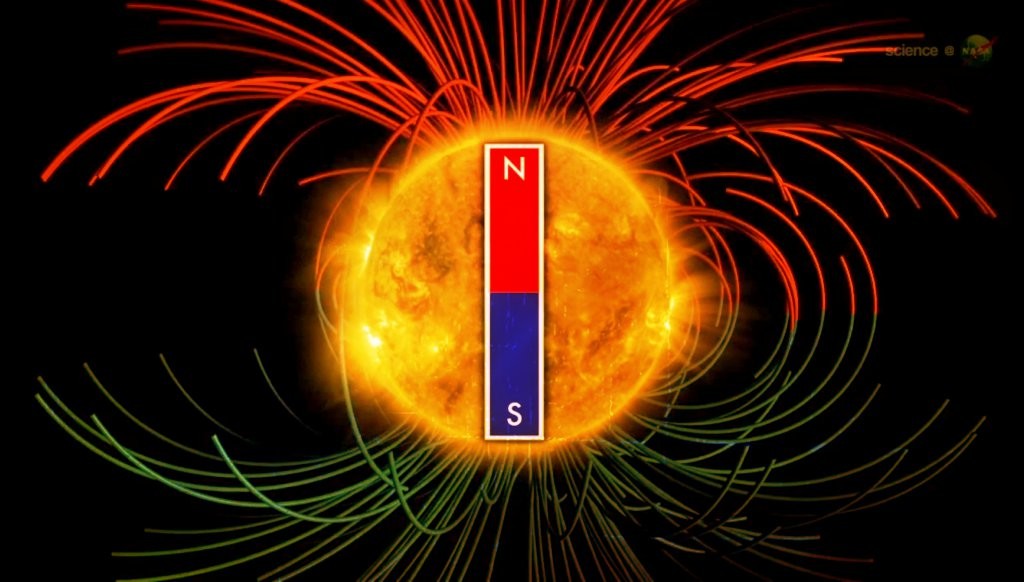NASA’s solar observatories revealed that the Sun’s magnetic field was about to “flip,” meaning to reverse its polarity. By the end of 2013, it was estimated that three to four months remained to complete the reversal of the solar magnetic field.
Effects and Phenomena of the Solar Magnetic Field Reversal
This shift triggered a domino effect throughout the solar system, explained solar physics expert Todd Hoeksema from Stanford University, USA. At that time, the Sun was in a period of high activity, marked by an increased frequency of solar flares, “coronal holes” (areas with high-speed solar winds) and solar eruptions (plasma emissions). These phenomena caused magnetic storms on Earth.
The reversal of the magnetic fields (the north and south poles) occurred precisely at the peak of solar activity as a result of the restructuring processes of its dynamics.
However, scientists stated there was no reason for human concern, as solar activity follows an 11-year cycle. “The Sun’s polar magnetic field weakened, dropped to zero and then reappeared with the reversed polarity; this is a normal element of the solar cycle,” explained Philipp Scherer, also from Stanford University.
NASA’s series of observations showed that at that time, the Sun’s hemispheres were not moving in unison towards the change: the north pole already showed signs of being ready and the south pole was just trying to catch up. “However, soon both changed polarity and began another solar cycle,” concluded Scherer.
Four Poles
Four magnetic poles could form on the Sun in the short term, as predicted by the National Observatory and Institute of Natural Sciences of Japan. The Sun’s magnetic poles usually switch every eleven years and generally coincide with the geographic poles.
It was possible for the south pole to change its polarity. For a period, both geographic poles of the Sun were positive. As a result, two temporary negative magnetic poles formed in the equatorial region.
These phenomena occurred on the Sun in the past, for example, in the 17th-18th centuries, which coincided with significant cooling of the Earth. The current appearance of four magnetic poles on the Sun could also have caused cooling of the planet.
Apocalyptic
The USA sounded all alarms as the solar cycle underwent a significant shift, ushering in an unexpected calm. As the Sun embarked on a new and highly intense cycle, it was anticipated to exhibit increased magnetic activity, more sunspots and frequent solar eruptions.
These phenomena, although it did not seem so, could have a tremendous impact on our current society, riddled with navigation systems and communications that could be suspended. And there was little time left.
Scientists predicted that the end of 2013 would be the peak of activity for the new cycle. Although the risk extended over the next six years. The dependence of modern societies, plagued with communication networks, satellites and mobile telephony that could collapse, exacerbated the consequences.
Thus, an extreme solar storm like the one expected had severe consequences for our way of life.
Troubling Background
The most powerful solar storm in history occurred in 1859, but its effects were limited since electrical power was still in its infancy. However, the auroras it caused could be seen from all corners of the planet.
Other milder, but more recent, storms have already shown their danger to mobile services, GPS, or electrical grids.
For example, in 1994, a solar storm caused two communication satellites to fall out of operation for hours and in 1989, it knocked out the hydroelectric power plant in Quebec (Canada) for over nine hours, resulting in hundreds of millions in losses.
What Would Be the Effects of “the Solar Storm of the Century”?
Reports commissioned by NASA, the US Army, the British Parliament and a group of experts from the European Commission believed that after five days, a real Armageddon would ensue.
To begin with, air and traffic accidents would multiply due to failures in route systems, landing systems, traffic lights and signage. Electrical systems would completely collapse, leaving homes, industries, refineries and chemical plants without power. Without existing action protocols, the consequences of this collapse were dramatic. Elevators became another critical point, complicating evacuations and leaving people trapped.
Simultaneous Electrical Fires
As demonstrated in 1859, great simultaneous electrical fires were also triggered. To make matters worse, the water supply stopped functioning beyond ground level, as pumping systems failed.
Gas stations were unable to supply fuel in the same way. Any means of transport, besides being a risk, was impossible to refuel. Although it hardly mattered, as ATMs also did not operate. Even banking databases could have disappeared.
Above all, communication systems were the most affected. Mobile phones, computers, radios and televisions failed in succession, leaving the population isolated and without information on how to respond to the chaos.
For this reason, US authorities have already issued recommendations to be prepared for what has been defined as “the solar storm of the century.”




